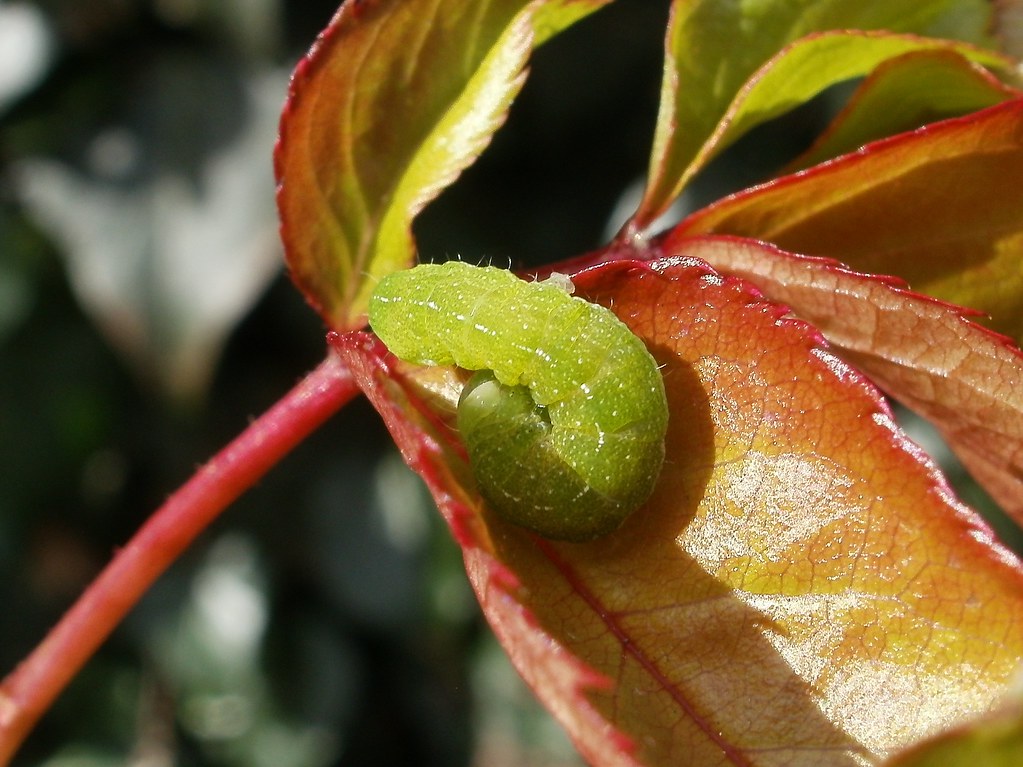I already introduced it in "The story so far" - this is my second Angle Shades caterpillar (Phlogophora meticulosa), which is of course the Moth Of The Blog...
28 MAR 2013 | ON VEGETATION | AT HOME GARDEN, SPRINGMARTIN HVC39 J3074
Angle Shades: 1L (Ye) (GYe)
Angle Shades caterpillar on rose This is the third Angle Shades caterpillar I've found in my garden - it's a common migrant Noctuid moth. I reared the first one I found (in 2010, on the exact same plant), and I'm doing the same with this one. At the minute it's under a half-eaten rose leaf in a cottage cheese carton on my bedroom windowsill, in the process of moulting its skin. That'll bring it to its penultimate or maybe third-last instar.
Update on Project 3B
I took the caterpillar indoors the following day, by which time it had moved up the plant to a spray of leaves precariously flapping in the breeze: |
| Angle Shades caterpillar on rose, 29 March 2013 |
On the windowsill in its cottage cheese carton, it grew and ate quite quickly, as caterpillars do...
.jpg) |
| Indoors, 29 March |
.jpg) |
| 1 April |
.jpg) |
| 2 April |
Just over a week later, it moulted onto its final instar (jargon buster: caterpillars periodically moult their skin; the periods between moults are the instars)...
 |
| Moulted head case, 5 April |
It took me a while to remember my tactic with the previous Angle Shades caterpillar (Rosebud, the blog icon) of feeding it elder leaves, to spare mum's roses...!
.jpg) |
| Nearly full grown, 9 April |
On 14 April I found it, with its velvety patterned complexion changed to a plain shiny yellow-green, spinning a loose cocoon of silk and chewed-up leaves in the bottom of the container. Angle Shades number one had done this and pupated and emerged successfully, but I suspected that, like other Noctuid caterpillars, it would much rather prefer some soil.
.jpg) |
| Turning yellowish as it prepares to pupate, 14 April |
So I provided some, and it dove right in!
.jpg) |
| Diving straight into the earth, 14 April |
And that's the last I saw of it. I moved the jar outside to give it normal conditions for pupation.
Based on how long it took Rosebud to go from spinning its cocoon to emergence (49 days) I'm predicting Angie will emerge around 2 June. So until then, I just have to keep the soil moist and wait.
And wait for the Brimstone pupa to emerge. And take care of James's two Lozotaenias. I got some good photos of the older Lozzy today - and a video clip - but that's another post for another day!

Very interesting to read your blog. I too found an Angle Shades caterpillar a few weeks ago which I've successfully raised to pupate. Any tips on how to keep it safe whilst its pupating? Also any idea how long it will take at this time of year?
ReplyDeleteHi Amanda. Best thing to do is keep it in soil in a ventilated container, in a shaded, sheltered spot outside. The important thing is not to let the soil get waterlogged or dried out. I'd say the pupa will probably wait until spring to finish development, but I'm not sure. Hope it goes well!
DeleteSam
He emerged successfully today. So pleased!
DeleteAmanda
Good good! It is a cracker of a moth, isn't it? : ) When you're done admiring it, it should be fine to release it outdoors - it'll snuggle up somewhere sheltered and hopefully find a mate when the warmer weather comes around.
DeleteSam
Thanks Sam. Fingers crossed for a successful emergence!
ReplyDeleteHi, I have recently found an angle shades caterpillar and have decided to look after it so I thought it would be nice to put in some soil from my back garden to make it feel more at home however I have spotted a few tiny bugs in the soil and I was wondering if this would affect the caterpillar would you happen to know anything about this?
ReplyDeleteApologies Emily - I thought I'd replied to you but it isn't showing up here. : L I know very little about soil insects so have no idea. Given that most caterpillars pupate in the soil I'd be farely sure it's safe! (Of course by now I'm guessing it's gone and pupated already!)
DeleteSam